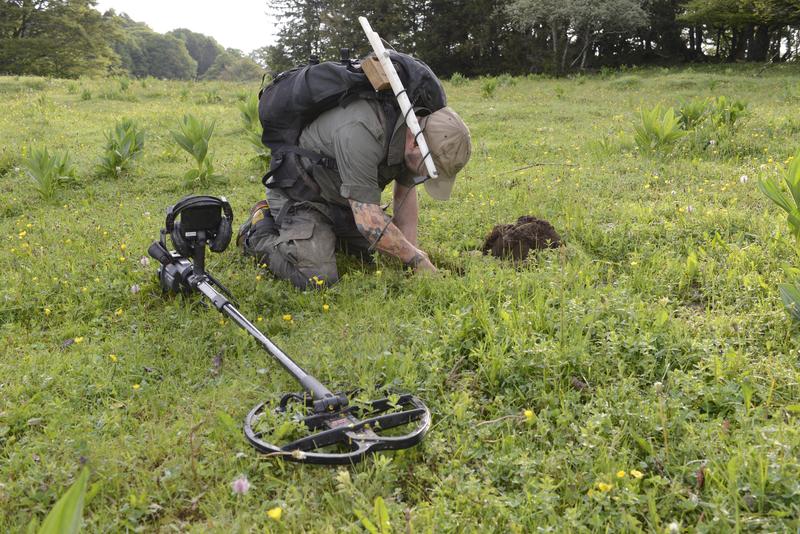
Meteorite hunters and scientists discover one of Europe’s most extensive meteorite strewn fields

Meteorite hunter in the huge meteorite strewn field near Twann in the Canton of Bern (Switzerland)
The most spectacular meteorite find to hit Switzerland documents a significant fall event in Europe: a huge meteorite strewn field near Twann in the Canton of Bern (Switzerland) has been identified by team coordinator Beda Hofmann from the Natural History Museum Bern, scientists from the University of Bern and about 50 meteorite hunters.
Three years of dedicated and tireless recovery expeditions have turned up 600 fragments belonging to the Twannberg Meteorite, a fall determined by Bern physicists and collaborating researchers from the Helmholz Center in Dresden-Rossendorf, Germany to have struck the Twann region about 160,000 years ago. This site represents one of nthe most extensive strewn fields in Europe, comparable with Europe’s two other big iron meteorite strewn fields, Morasko (Poland) and Muonionalusta (Northern Sweden).
Noble gas analyses conducted at the Physics Institute, University of Bern suggest that the “Twannberg” meteorite, as it is officially known, was approximately 6 to 20 meters in diameter, corresponding to 1,000−30,000 tons of massive iron. In the case of Morasko, estimates are at 1000 tons. Twannberg is considered one of the World’s largest known iron meteorite showers.
At the time of the meteorite fall, numerous fragments fell as a meteorite shower over a region of yet unknown expanse in the Swiss Jura, north of Lake Biel in today’s Canton of Bern. Although the assessment of this spectacular event and strewn field is still in progress, it is clear that the strewn field is extensive and that the number of meteorite fragments is estimated way over 1000.
Up to now, the strewn field covered a distance of 5 kilometers. However, in comparison to Muonionalusta (10 km) and Morasko (2.7 km) it is plausible that the strewn field extends for up to 15 kilometers. Up to now no crater has been detected, which likely reflects the fact that glaciers covered the region 24,000 years ago.
The Twannberg meteorite is not only the biggest of the eight meteorites recovered in Switzerland but it is also the only meteorite to be documented by numerous fragments. Twannberg represents one of the rarest examples of iron meteorites, the class IIG of which only 6 recognized finds are known. In addition to Switzerland, IIG iron meteorites have been found in the USA, Chile and South Africa.
Historical Context of the Twannberg Meteorite
The first Twannberg meteorite was discovered in 1984 by a farmer collecting stones in a field. For a long time this was the only known find. In 2000 another mass was found in the attic of an old house in Twann. By 2007, three small masses were additionally reported by gold prospectors from the Twannbach (Twann stream). Since this material was either transported by human agency or by stream away from the site of original impact, these finds could hardly document this unique fall.
New finds collected during 2009-2013 in the Twannbach ravine revealed 77 meteorites reaching weights up to 177 grams. Although these new finds increased in number, the site of impact still remained a mystery since it was unclear how far they had been transported down stream. Since so many meteorites were found in such a short time, it became clear that these meteorites fell as a shower. In 2013, a decisive find (TW83) was collected in the same field as the first in 1984.
Dr. Beda Hofmann, a renowned capacity in international meteorite research and head of Earth Sciences at the Natural History Museum Bern, has conducted 5 search expeditions since 2014. His team of 50 meteorite rockhounds, equipped with metal detectors and convening from as far away as Russia, the Czech Republic, Germany and diverse corners of Switzerland have scoured the region for additional fragments. Like precious truffles underground, new meteorites were detected at a typical depth of 15 cm. By June 2016, 570 meteorites weighing a total of 72.5 kilos were found. Meanwhile Beda Hofmann claims still more returns from the Twann strewn field and will no doubt report even more in upcoming years.
Special Exhibition presents parts of the Twannberg Meteorite
On August 19th the Natural History Museum Bern will open its doors for special exhibition of the “Twannberg Meteorite – Hunters of a lost treasure”, enabling a rare glimpse into the exciting recovery of meteorites and meteorite research.
Exhibition website with additional information and photos: www.twannbergmeteorit.ch
Contact: Simon Jäggi, Director of Communication, simon.jaeggi@nmbe.ch, +41 31 350 72 97
Beda Hofmann, Head Earth Sciences, beda.hofmann@nmbe.ch, +4131 350 72 40
Marc Jost, Meteorite collector, spacejewels@bluewin.ch, +41 79 427 9657
http://www.twannbergmeteorit.ch
http://www.nmbe.ch/informieren/aktuell/mediencorner
http://www.hou.usra.edu/meetings/metsoc2016/pdf/6160.pdf
http://www.hou.usra.edu/meetings/metsoc2016/pdf/6187.pdf












